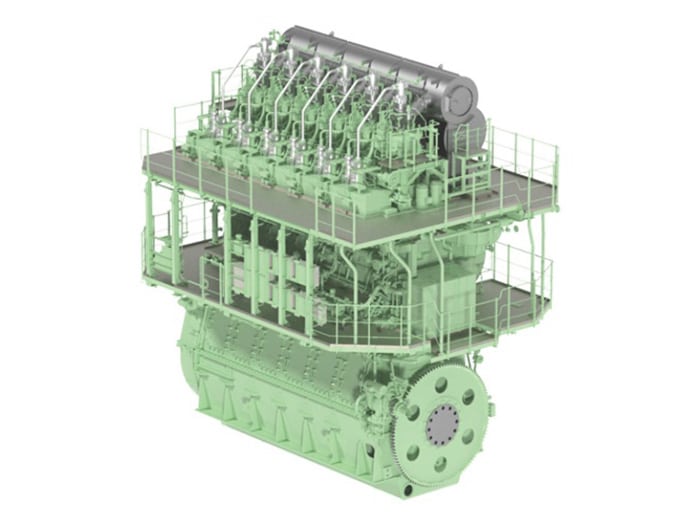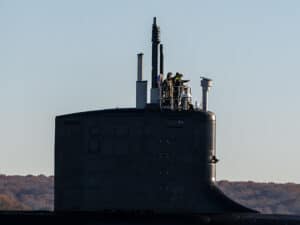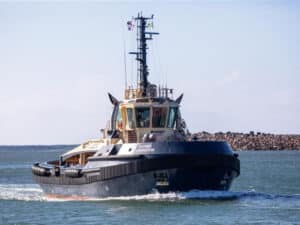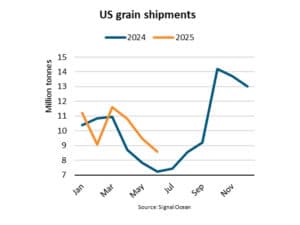
Is J-Eng edging ahead on future fuel engines?
Written by Nick Blenkey
J-Eng plans to launch 60 centimeter bore ammonia-fueled UEC60LSJA engine on the market after 2026.
One of the world’s three largest marine engine brands, Japan Engine Corporation (J-Eng) may be edging ahead of the pack in developing large two-strokes capable of operating on ammonia and hydrogen.
J-Eng, whose main shareholders include Mitsubishi Heavy Industries (MHI), is the developer and manufacturer of the long-running UE engine series, which last year reached the 40 million installed horsepower milestone.
Earlier this month, the company reported that, under a project backed by Japan’s Green Innovation Fund and New Energy and Industrial Technology Development Organization (NEDO) it has already carried out what it claims is the world’s first “zero-emission fuel” ammonia co-firing operation of a large low-speed two-stroke ship’s engine and has begun testing of a hydrogen fuel injection device for a large low-speed two stroke.
By “co-firing,” J-Eng means that the ammonia is being combusted in combination with fuel oil.
The ammonia-fueled test engine is installed at MHI’s Research and Innovation Center (Nagasaki) and has been fitted with J-Eng’s stratified injection system technology, using fuel oil as a pilot fuel.
Ammonia is a flame-retardant fuel, and the technical challenge is to burn the fuel efficiently and minimize the generation of NOx which has a high global warming potential. J-Eng addresses these issues through its stratified injection technology. This works by injecting the ammonia fuel in such a way that it is sandwiched between the combustible pilot fuel and post fuel, making possible to achieve advanced combustion control, improve the ammonia co-combustion rate, and reduce the temperature.
J-Eng will operate the test engine with ammonia fuel under various conditions over the next year.
A new facility to supply ammonia fuel to the test engine has also been installed adjacent to the building where the test engine is located, and the knowledge and the experience gained from the operation of this facility will be fed back to the development of ammonia fuel supply facilities on board for ships.
J-Eng’s aim is to have a 50 centimeter bore, ammonia fueled UEC50LSJA engine completed in 2025 under the NEDO Green Innovation Fund project. It plans to launch the UEC60LSJA engine, an ammonia-fueled engine with a bore of 60 centimeters, which is optimal for a main engine, on the market after 2026 and has already started development of its oil-fired “twin,” the UEC60LSH engine, which is the successor model to the long running UEC60LSE engine.
J-Eng’s aim is to have a 50 centimeter bore, ammonia fueled UEC50LSJA engine completed in 2025 under the NEDO Green Innovation Fund project. It plans to launch the ammonia-fueled 60 centimeter bore UEC60LSJA engine on the market after 2026 and has already started parallel development of its oil-fired “twin,” the UEC60LSH engine, which is the successor model to the long running UEC60LSE engine.
HYDROGEN FUELED ENGINE
J-Eng says its hydrogen-fueled UEC-LSGH engine will be developed by applying technologies cultivated through the development of dual-fuel (DF) gas engine. It says the hardest technical challenge how to control hydrogen’s easy combustibility and that high-pressure hydrogen injection into the combustion chamber can bring stable combustion to solve this issue.
The first hydrogen-fueled UEC35LSGH engine. developing about 5,000 kW with a bore of 35 centimeters is expected to be complete in 2026.
A key technology for the engine, the fuel injection device, has already been installed at the company’s head office plant in Akashi city and operational tests have begun.




